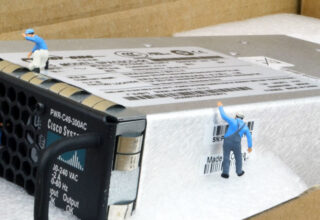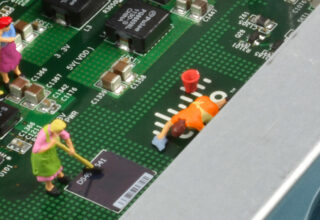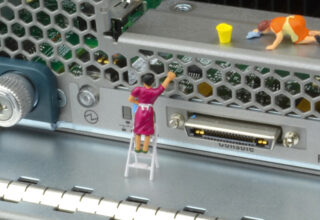CISCO Refurbished
- Manufacturer
- CISCO
- Condition
- Refurbished
- Availability
- In Stock
- List Price/RRP
- US$40.00
Description
The CAB-COMBO-2M is a product supplied by CISCO that combines two cable types into one cable, making it easier to manage and reduce clutter in network installations. The cable features two connectors, an RJ-45 and a DB-9, allowing it to be used for both Ethernet and serial connections. The cable is 2 meters long, providing ample length for many types of installations. The CAB-COMBO-2M is compatible with a wide range of CISCO networking equipment and is a reliable and cost-effective solution. It is simple to install and use, making it ideal for both novice and experienced network technicians. Overall, the CAB-COMBO-2M is a versatile and practical product that simplifies network infrastructure management and helps maintain a tidy and organized workspace.
- Part Code
- CAB-COMBO-2M
- Description
- Combo cable USB and HDMI. Grey. 2 meters
- Manufacturer
- CISCO
- End of Hardware Support
- Yes (31 January 2026)
- End of Sale
- Yes (30 January 2021)
- End of Life
- Yes (30 October 2020)
Features and benefits
Expand
Features and benefits
Share and collaborate on whiteboard content with meeting participants on the Cisco Webex Board, Cisco Webex DX80 or Cisco Webex Teams app.
Meeting participants using the Cisco Webex Room Series will see shared whiteboards as content on-screen and edit content on their paired Cisco Webex Teams app. Cisco SX Series and Cisco MX Series will get a notification of shared whiteboards on-screen and can view shared whiteboard content and edit content on their paired Cisco Webex Teams app.
Supported on cloud-registered devices only.
In-person video: With a large 23-inch screen and best-in-class video and audio capabilities, the DX80 allows for life-like experiences.
Top-notch monitor: You can use the DX80 as an external monitor when plugged into a laptop. It has a high-contrast LED panel with a wide viewing angle and a full touch surface.
Document camera: You can tilt the camera located on top of the DX80 down to allow sharing of physical content and drawings.
Inclinable screen: The DX80 accommodates users who want to sit and use it at a reclined angle to type or draw at their desk comfortably. You can easily pull the device toward yourself; it reclines to a 40° angle to the table.
Automatic wake-up: The collaboration system automatically detects when someone enters the room. It "wakes-up," says hello and provides guided instructions to make it effortless to start using the device.
Enjoy the easy on-screen control interface accessible with a single tap on the screen.
Audio is communicated through full-duplex, full-band audio (CD quality).
Provisioning and configuration are easy with Cisco Unified Communications Manager or with Cisco TelePresence Video Communication Server (VCS) and Management Suite (TMS).
The DX80 also registers to Cisco Webex.
Product specifications
Expand
Product specifications
Codec
Camera
Display
Microphones and loudspeaker
Included: Screen cleaning cloth, HDMI cable (2m), USB cable (2m), Ethernet cable (2.9m), and power supply
Resolution: 1920 x 1080 (16:9)
High-contrast IPS LED panel
Contrast ratio: 1000:1 (typical)
Viewing angle: +/–178 degrees (typical)
Response time: 5 ms (typical)
Brightness: 215 cd/m2 (typical)
Color depth: 16.7 million colors
Color gamut 72% (of NTSC)
10-point multitouch surface
You can tilt the screen from an angle of 11° to 50° from the vertical
You can tilt the camera from an angle of –5° to 70° from the display
You can lift the connector lid fully and lock it to the back of the unit with magnets
Four digital microphones are mounted in two arrays
Loudspeaker frequency range: 70 Hz to 20 kHz
Microphones frequency range: 100 Hz to 20 kHz
38° vertical field of view
Resolution: 1080p30
F 2.2
Privacy shutter
HDMI type A port output (not in use)
High-speed USB 2.0 ports:
Three standard type A ports enable wired or wireless (dongle) headsets and handset use
One standard type B port (reserved for future use)
One Micro-B USB port with native RS-232 (serial port, intended for service only)
Maximum of 500-mA power output at 5V or 2.5W for each USB port
Mute
Microphone LED indicator (mute)
Power button LED indicator (power on, sleeping, message waiting, and error)
Low-power standby mode
Directive 2014/30/EU (EMC Directive) – Class A
Directive 2014/53/EU (Radio Equipment Directive)
Directive 2011/65/EU (RoHS)
Directive 2002/96/EC (WEEE)
NRTL approved (Product Safety)
FCC CFR 47 Part 15B (EMC) – Class B
FCC Listed (Radio Equipment)
Features common to Cisco Webex and on-premises registered devices
Expand
Features common to Cisco Webex and on-premises registered devices
640 x 480
720 x 480
800 x 600
1024 x 768
1280 x 720
1366 x 768
1920 x 1080
High-definition inputs use progressive video formats.
Extended Display Identification Data (EDID)
352 x 288 @ 30 fps (CIF)
512 x 288 @ 30 fps (w288p)
576 x 448 @ 30 fps (448p)
768 x 448 @ 30 fps (w448p)
704 x 576 @ 30 fps (4CIF)
1024 x 576 @ 30 fps (w576p)
640 x 480 @ 30 fps (VGA)
800 x 600 @ 30 fps (SVGA)
1024 x 768 @ 30 fps (XGA)
1280 x 1024 @ 30 fps (SXGA)
1280 x 720 @ 30 fps (720p30)
1280 x 768 @ 30 fps (WXGA)
1920 x 1080 @ 30 fps (1080p30)
1440 x 900 @ 30 fps (WXGA+)
1680 x 1050 @ 30 fps (WSXGA+)
High-quality 20-kHz stereo audio
Acoustic echo cancellers
Automatic Gain Control (AGC)
Automatic noise reduction
Software features for endpoints registered on-premises or to Cisco Hosted Collaboration solution
Expand
Software features for endpoints registered on-premises or to Cisco Hosted Collaboration solution
1080p30 from 1472 kbps
Active control (participants list, active speaker and content sharing, end participant call, and muted participants)
Layout controls
Self-View
Far-end camera control
Binary Floor Control Protocol (BFCP) (SIP) dual stream
Support for resolutions up to 1080p (1920 x 1080)
Standards-based: Advanced Encryption Standard (AES)
Automatic key generation and exchange
Supported in dual stream
Add consultative call
Adjustable ringing and volume levels
Adjustable display brightness
Auto-answer
Auto-detection of headset
Call forward
Call forward notification
Call-history lists
Caller ID
Corporate directory
Conference (ad hoc)
Do Not Disturb (DND)
Extension Mobility service
Favorites
Hold (and resume)
Join (ad hoc merge)
Message waiting indicator
Mute (audio and video)
Network profiles (automatic)
Self-View (video call)
One-Button-To-Push (OBTP)
Shared line
Single Number Reach (SNR)
Transfer
Voicemail
Video system control: Use the Cisco Proximity app on a mobile device to initiate, answer, or hang up a call on the on-premises registered endpoint. You can also move the call from the mobile device to the DX80 and vice versa
View shared content: Use the Cisco Proximity app on a mobile device to view the content being shared. Use the Cisco Proximity app on a laptop to share the content wirelessly in and out of a call
The Cisco Proximity app on iOS, Android, Windows, and MacOS is enabled for pairing by default. Control is available to anyone with the Cisco Proximity app. Alternatively, users who do not have a mobile or desktop device or the Cisco Proximity app can control the system with the DX80 touchscreen
Differentiated Services (Quality of Service [QoS])
IP adaptive bandwidth management (including flow control)
Dynamic playout and lip-sync buffering
Date and Time support with Network Time Protocol (NTP)
Packet loss-based down speeding
URI Dialing
TCP/IP
Dynamic Host Configuration Protocol (DHCP)
802.1x network authentication
802.1Q virtual LAN
802.1p (QoS and Class of Service [CoS])
Clear Path v1 and v2
Custom panel creation from the web UI interface
Global panel accessible in the system bar tray
Home screen panel accessible from the control tray
In-call panel accessible from the in-call tray
Native table with Unified CM
Cisco Expressway
Native registration with Expressway
Cisco Webex
Third-party H.323 Gatekeepers and standards-based SIP proxies
Support for both static and auto configuration (stateless address auto configuration)
IP administration password
Menu administration password
Disable IP services
Network settings protection
Total management through embedded Simple Network Management Protocol (SNMP), Telnet, SSH, XML, and Simple Object Access Protocol (SOAP)
Remote software upload: Through web server, HTTP, and HTTPS
Corporate directory (through Cisco Unified Communications Manager and Cisco TMS)
Server directory supporting Lightweight Directory Access Protocol (LDAPP and H.350 (requires Cisco TelePresence Management Suite)
Call history with received, placed, and missed calls with date and time
Software features for the Cisco Webex Teams Service or Cisco WebEx on Annuity
Expand
Software features for the Cisco Webex Teams Service or Cisco WebEx on Annuity
With Cisco Webex Hybrid Calling Service enabled, the DX80 can connect to Cisco Unified Communications Manager or Cisco Hosted Collaboration Solution. Assign an extension and E.164 number from. your enterprise dial plan to the Webex DX80 Users can make and receive calls to or from other Cisco Unified Communications Manager registered devices and external PSTN numbers using the assigned number.
In a multiparty call, Cisco Webex will send several independent streams and maintain a constant bitrate.
In conditions where the network does not allow full bitrate, the rate will be automatically adjusted and the video gracefully degraded.
Refer to this article for more information: https://support.ciscospark.com/customer/en/portal/articles/1911657-firewall-and-network-requirements-for-the-cisco-spark-app.
Active control (participants list, active speaker and content sharing, and end participant call)
Self-View
Room system control: Use the Cisco Webex Teams app on a mobile device to initiate, answer, or hang up a call on the Cisco Webex room devices
Move calls: Smoothly move a call from the Cisco Webex Teams app on a mobile device to a Webex DX80 when walking into the room. Or move a call from the Cisco DX80 to the Cisco Webex Teams app when leaving the conference room
The Cisco Webex Teams app on iOS and Android is enabled for pairing by default. Control is available to anyone with a Cisco Webex Teams app, even the free version. Alternatively, users who do not have a mobile or desktop device or the Cisco Webex Teams app can control the system with the DX80 touch screen
Software features for the android-based software
Expand
Software features for the android-based software
Home Screen supports up to five separate screen views or pages with a 12 x 9 icon grid
Landscape-orientated applications are supported
On-screen keyboard is supported
Calendar
Camera
Clock
Contacts
Direct dial
Internet Message Access Protocol (IMAP)
Post Office Protocol 3 (POP3)
Microsoft Exchange ActiveSync
Favorites
Gallery
Phone features (for example, forward all, privacy, Do Not Disturb (DND), mobility, and Self-View)
Wallpapers (including live wallpapers)
Web browser
Gmail
Google settings
Maps
Play Books
Play Magazines
Play Movies
Play Music
Google Now
Cisco Jabber Instant Messaging (which offers chat and presence capabilities)
Cisco Webex
Quick Contact Badge (allows you to easily collaborate with your contacts to place a call, send an email message, send an Instant Message [IM], or start a WebEx meeting)
Visual Voicemail
Simple mode that hides applications and accounts and provides only voice and video call capabilities
Public mode based on simple mode with restrictions on user settings modifications
Google Play access can be administratively disabled (default). Applications from “unknown sources” can be administratively disabled (default):
The administrator can optionally install applications using Cisco Unified Communications Manager with the APK file
With Company Photo Directory (ability to set up and link photo directory URL image location associated with respective user), the administrator can set up and link a photo-directory URL image location associated with a respective user
https://developer.cisco.com/site/dxseries/overview/index.gsp
Bulgarian, Bulgaria (bg_BG)
Catalan, Spain (ca_ES)
Chinese, PRC (zh_CN)
Chinese, Taiwan (zh_TW)
Croatian, Croatia (hr_HR)
Czech, Czech Republic (cs_CZ)
Danish, Denmark (da_DK)
Dutch, Netherlands (nl_NL)
English, Britain (en_GB)
English, United States (en_US)
Finnish, Finland (fi_FI)
French, France (fr_FR)
German, Germany (de_DE)
Greek, Greece (el_GR)
Hebrew, Israel (he_IL)
Hungarian, Hungary (hu_HU)
Italian, Italy (it_IT)
Japanese (ja_JP)
Korean (ko_KR)
Latvian, Latvia (lv_LV)
Lithuanian, Lithuania (lt_LT)
Norwegian bokmål, Norway (nb_NO)
Polish (pl_PL)
Portuguese, Brazil (pt_BR)
Portuguese, Portugal (pt_PT)
Romanian, Romania (ro_RO)
Russian (ru_RU)
Serbian, Republic of Serbia (sr_RS)
Slovak, Slovakia (sk_SK)
Slovenian, Slovenia (sl_SI)
Spanish, Spain (es_ES)
Swedish, Sweden (sv_SE)
Thai, Thailand (th_TH)
Turkish, Turkey (tr_TR)
Abbreviated dialing
Adjustable ringing and volume levels
Adjustable display brightness
Auto-answer
Auto-detection of headset
Barge (cBarge)
Callback
Call Chaperone
Call forward
Call forward notification
Call-history lists
Call park (including Directed Call Park and Assisted Directed Call Park)
Call pickup
Call timer
Call waiting
Caller ID
Corporate directory
Conference (ad hoc)
Direct transfer
Divert (iDivert)
Do Not Disturb (DND)
Cisco Extension Mobility service
Fast-dial service
Forced-access codes and client matter codes
Group call pickup
Hold (and resume)
Intercom
International call logging
Join (ad hoc)
Last-Number Redial (LNR)
Malicious-caller ID
Message-Waiting Indicator (MWI)
Meet-me conference
Mobility (Cisco Mobile Connect and Mobile Voice Access)
Music on Hold (MoH)
Mute (audio and video)
Network profiles (automatic)
On- and off-network distinctive ringing
Personal directory
PickUp
Predialing before sending
Privacy
Private Line Automated Ringdown (PLAR)
Ring tone per line appearance
Self-View (video call)
Service URL
Shared line(s)
Silent Monitoring and Recording
Time and date display
Transfer (ad hoc)
Visual Voicemail
Voicemail
Secure credential storage
Device authentication
File authentication and encryption
Image authentication and encryption
Signaling authentication
Random bit generation
Hardware cryptographic acceleration
Encrypted configuration files
Encrypted file system
Manufacturer-Installed Certificates (MIC)
Locally Significant Certificates (LSC)
X.509 Digital Certificates (DER encoded binary); both DER and Base-64 formats are acceptable for the client and server certificates; certificates with a key size of 1024, 2048, and 4096 are supported
Extensible Authentication Protocol: Extensible Authentication Protocol - Flexible Authentication via Secure Tunneling (EAP-FAST)
Extensible Authentication Protocol: EAP Transport Layer Security (EAP-TLS)
Protected Extensible Authentication Protocol - Generic Token Card (PEAP-GTC)
Secure Real-Time Transport Protocol (SRTP)
HTTPS for clients
Web Proxy (manual configuration or auto configuration of Protected Access Credential [PAC] files)
NT LAN Manager (NTLM) and Kerberos authentication
ActiveSync remote wipe (email, contacts, calendar, etc.)
Self-service wipe
Wipe after unsuccessful login attempts
Factory reset
Ability to disable USB
Ability to disable speakerphone
Ability to disable headset
Secure digital I/O (SDIO) enable/disable
Access to Android market
Screen lock and automatic lock (Personal Identification Number [PIN] or password) device
Android Debug Bridge (ADB)
Replacement parts
Expand
Replacement parts
Accessories
Expand
Accessories
Refurbished CISCO CAB-COMBO-2M datasheet
Download PDF
Product datasheet
Download PDF - 736.079 KB








